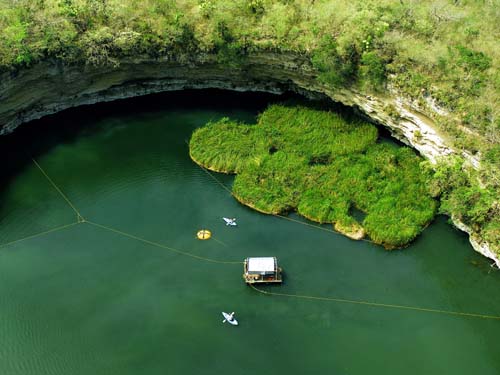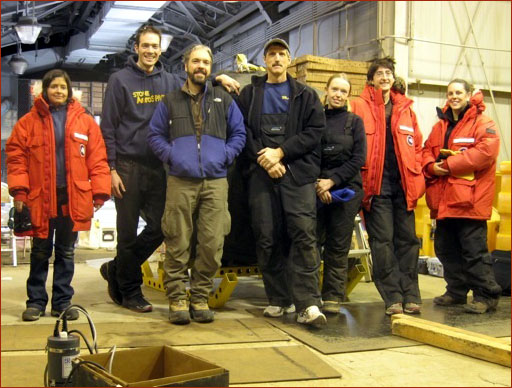Antarctica
2009
| |||||||||||||||||||||||||||||||||||||||||||||||||
| |||||||||||||||||||||||||||||||||||||||||||||||||
| |||||||||||||||||||||||||||||||||||||||||||||||||
The ENDURANCE project is funded by NASA and the National Science Foundation, and the vehicle is the second generation of the DEPTHX vehicle, which explored sinkholes in northern Mexico in 2007. Its mission in Lake Bonney is to take water chemistry data, make a 3-D map of the lake, and, hopefully, get high-resolution images of the portion of Taylor Glacier that meets Lake Bonney under the permanent ice cap of the lake. It is able to do all of this autonomously, that is, not by "remote control," but by making decisions on its own, based on input it gets from its environment from its nearly 100 sensors, including sonars, cameras, and its sophisticated ring laser gyro (which we call the "IMU" - Internal Measurement Unit, a device which required us to get U.S. Department of Defense clearance to ship it through New Zealand on its way down here). Mission planning is done in advance by the team, who input a set of gridpoints for the vehicle to visit and from which to take water chemistry data. The vehicle is linked by fiber optic to mission control, a corner of the bot house where all the programmers are linked up to watch this data collect in real time, as well as where they watch over the bot to make sure it is behaving as expected.

DEPTHX exploring Cenote Zacaton in Tamaulipas, Mexico. This was the deepest hole explored at over 1000ft deep. Mission control is located on a floating dock, and floating patches of zacate grass are lassoed to the walls to keep them out of the way.
Stone Aerospace (Bill Stone specifically) is a co-investigator of the ENDURANCE Project. We are an engineering firm, and as such are not the ones calling the shots on what data is collected and the priority of said data. This is done by the principal investigator, Dr. Peter Doran of University of Illinois at Chicago, and co-investigator Dr. John Priscu of Montana State University. The ENDURANCE vehicle is collecting a lot of the data that they normally collect in a manual fashion (by melting several different holes throughout the ice cap on a lake) but much more efficiently and while disturbing the ice cap much less. In addition to that, it is mapping the lake and taking lots of images, both of which would be difficult or impossible to achieve manually. So this is the science that is being done in real time this season.
ENDURANCE as a technology, however, is where our time here is much more of a learning experience. Where NASA's funding comes into all of this is that ENDURANCE is a prototype for a much smaller vehicle that NASA wants to send to Jupiter's moon Europa, which most scientists agree has a liquid water ocean beneath its miles-thick surface of ice. This ocean is believed to be one of the most likely places in the solar system to find extraterrestrial life.

My favorite artistic rendering of Europa's surface, by Kees Veenenbos.
So while we spend the season collecting data for use by these scientists, Antarctica is also providing the vehicle with proving grounds of sorts for this very ambitious and exciting mission. This future project is by no means funded yet, so it hangs in the balance. The success of last year's mission has definitely motivated the NSF to try to find it funding, however, because of the logistics and expense of bringing a 3000-pound, 7-foot wide robot to Antarctica. Data like we collected last year is sought for other lakes in the Dry Valleys here, so to miniaturize the robot to something a couple of people could carry would be a great advantage for all. ENDURANCE is the size it is because, to save money, it was built with "off the shelf" components. Still, it cost millions of dollars, so you can see that if NSF is motivated to get us funding for a custom-built mini-robot, just how much money in logistics that it will have to save them down the road to be worth them spending the money on a brand new vehicle.
Science is expensive, but not typically profitable. In an economy like this, I'm lucky to still be working anywhere, and I'm even luckier to be able to be doing this. Working as a technician for Stone Aerospace, I have done everything from running grinders across rust-ridden gantry cranes to proofreading computer code, which means hardly a boring moment at work. And considering my long-time interest in astronomy and space exploration, one would think that I looked high and low for this opportunity, but in fact it found me, at a time when I probably would have taken any job I could get. You can hardly get better fortune than that.

The Stone Aerospace ENDURANCE Field Team, 2009: Shilpa Gulati, Kristof Richmond, Bart Hogan, Bill Stone, Vickie Siegel, Chris Flesher, and moi (clearly carrying everything I own in my coat), Rachel Price.
Now if it could only be 75 degrees for a couple of days, that would be great! Thanks!
More information, if you are so inclined:
Bill's Ted Talk (highly recommended)
About ENDURANCE from the Stone Aerospace website
Article in Scientific American about ENDURANCE from 2008
Insightful article about Bill in Wired Magazine from 2004